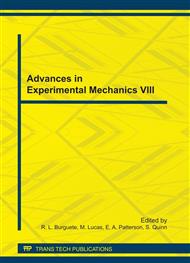p.357
p.363
p.369
p.375
p.381
p.387
p.393
p.399
p.405
Acoustic Emission Source Characterisation in Large-Scale Composite Structures
Abstract:
Damage detection and location in aerospace composites is currently of great interest in the research community and is being driven by the need to reduce weight of commercial aircrafts and hence make substantial environmental improvements. The increased use of composites as safety critical components has led to the need for development of structural health monitoring (SHM) systems. Acoustic Emission (AE) offers an excellent potential for delivering the necessary information of damage detection to maintenance engineers in terms of location however there are currently no methodologies that can use AE signals to characterise damage sources. This paper explores a methodology for damage characterisation based on measuring the amplitude ratio (MAR) of the two primary plate wave modes, to allow identification of in-plane (matrix cracking) and out-of-plane sources (delamination). Results from a large-scale buckling test show good correlation between signal characterization and observed damage mechanisms.
Info:
Periodical:
Pages:
381-386
Citation:
Online since:
August 2011
Authors:
Price:
Сopyright:
© 2011 Trans Tech Publications Ltd. All Rights Reserved
Share:
Citation:


